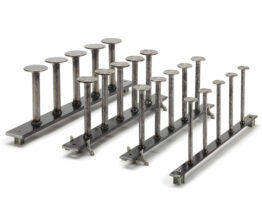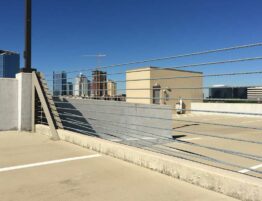
One of the frequent issues that comes up in barrier cable design is the removal of stanchions. These are short posts that hold the barrier cables in position. They serve two functions.
First, they control the deflection of the barrier cable during an impact. The cables are held in place at each column and stanchion, keeping the length of the deflected span short. As you can imagine, it takes a lot more energy to stretch a cable 18 inches if it’s 18 feet long than it does to stretch a cable 18 inches if it’s 40 feet long.
Second, they control the horizontal spacing of the barrier cable. The same logic applies as above; it is harder to spread the cables on an 18-foot span than on a 40-foot span. However, it might not be obvious that the barrier cable also sags under its own weight. Controlling this sag is actually the first step in determining the jacking force for a barrier cable.
Unfortunately, stanchions are frequently value-engineered after the remainder of the project is complete. Thus, designers are forced to examine ways to make the barrier cable system work with a new, greatly increased span.
The first step is to check the calculations to determine if a larger jacking force will allow the system to work at the increased span. However, this imposes a greater load on the remainder of the structure. The barrier cable designer and the Engineer of Record must work closely together to ensure that these increased loads can be carried by the system as installed.
Next, the designer can create a spacer that prevents the cables from spreading. This can take many forms, and is generally subject to the Architect’s approval. Advanced Post-Tension has designed many spacers, and is happy to discuss any project’s requirements.



